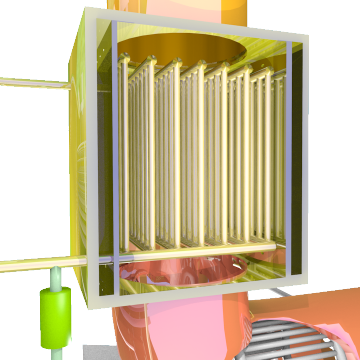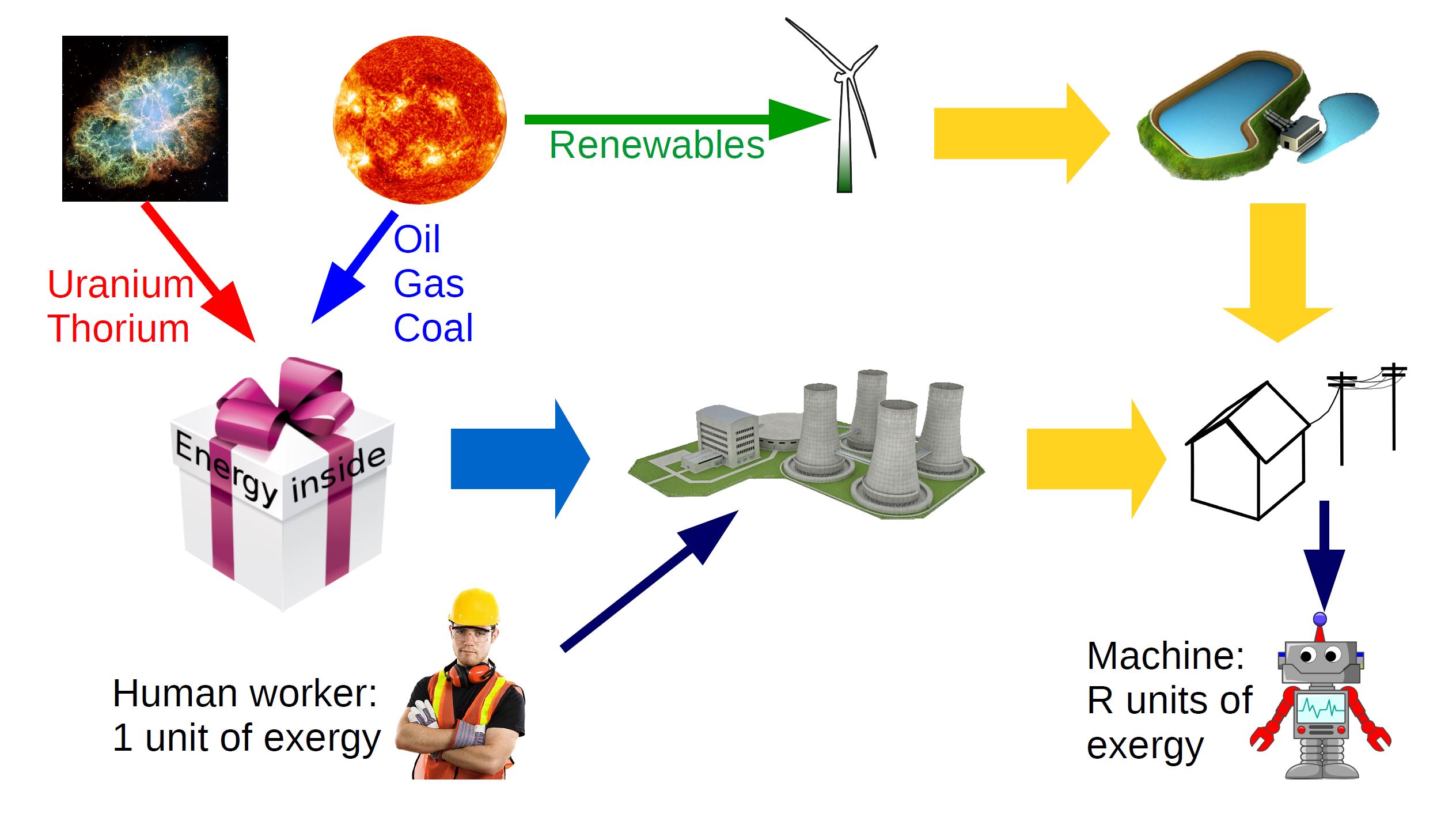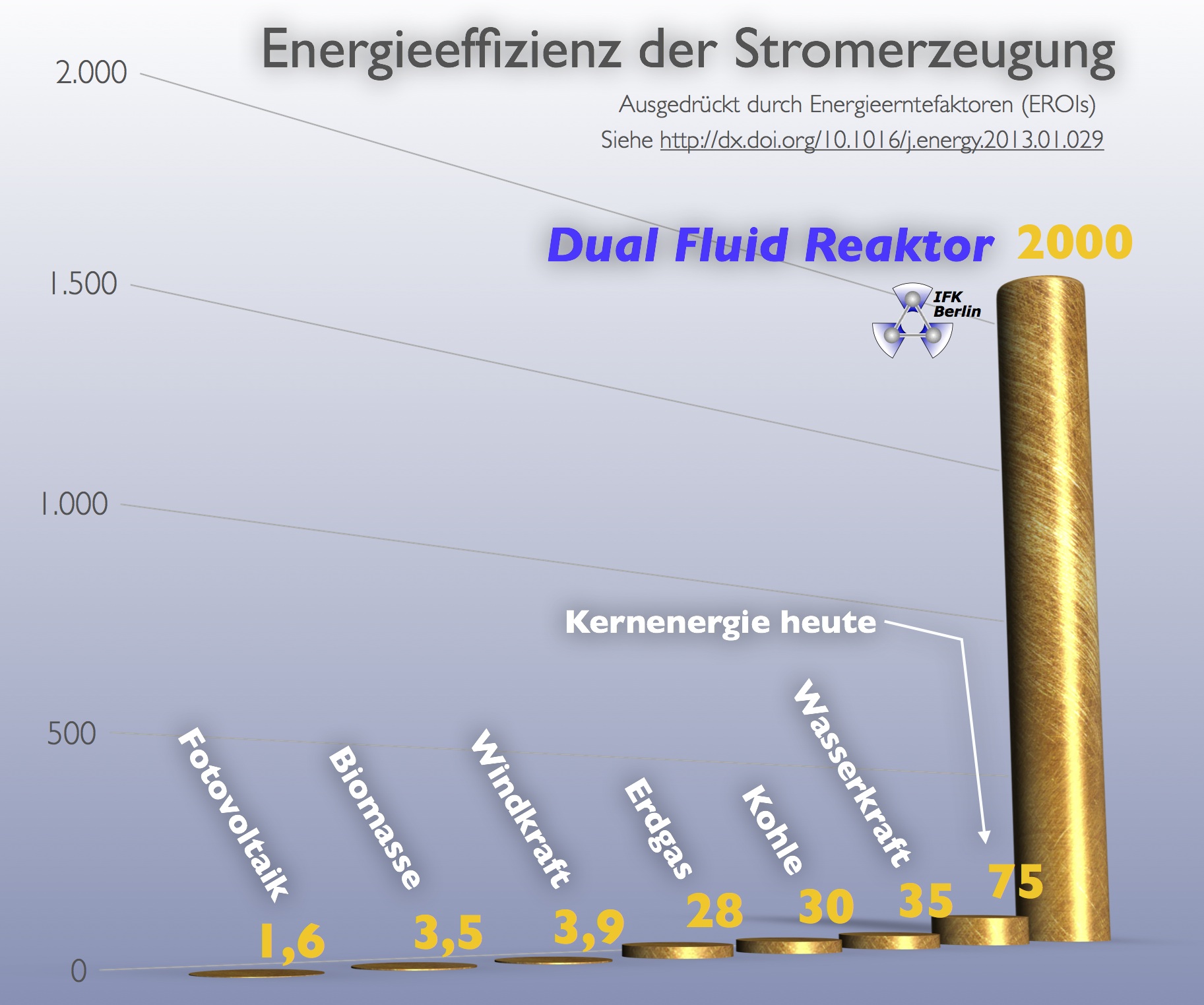Abundant Energy?
“There is an abundance of solar energy? A square some hundred kilometers in side length in the Sahara desert, filled with concentrating solar troughs, could supply all of humanity with energy. Neither fossil fuels nor nuclear are needed.”
Is this true?
The numbers seem to say yes: World primary energy consumption was at 18,600 gigawatts in 2016. Concentrating solar plants in deserts gather around 20 W per square kilometer — this means that a square array 960 km in side length could supply the world.
Realistically, a worldwide renewables-only economy would construct several smaller arrays in different deserts, combined with mighty offshore windfarms etc. — but these suggestions have a catch. It is the so-called EROI (Energy Returned on Investment).
The EROI
Why do we use technology at all? Goods can be carried on human backs instead of a freight train, emails and SMS can be replaced by envoys, thousands of human computers with pen and paper replace a single electronic one… this would through us back to the bronze age: Much more work with far smaller results. Machines take our jobs — luckily! They are the new slaves made from steel, plastics, copper, silicon.
The EROI tells us how much work a certain technology can take off our shoulders.
Der Erntefaktor sagt uns, wieviel Arbeit uns eine bestimmte Technologie abnehmen kann.
It is defined as follows: EROI = exergy delivered by a certain type of machine over its entire lifetime divided by the exergy needed to build, fuel, maintain and finally decomission it.
Exergy is directed energy: Rotating wheels, electric currents, lasers, etc. Diffuse energy, such as heat or electronic noise, is called anergy. In order to add exergy to a system, work must be expended, this means: A force must act on it over a certain distance — e.g. a motor’s mechanical force or the electromagnetic forces in a dynamo. The increase in exergy is equal to the value of work expended (unit Joule). Anergy can only be transformed partially into work (or exergy), any kind of exergy always ends up completely as anergy (e.g. through friction or electric resistance). For this reason, exergy is called high-value, anergy low-value energy.
The higher a certain technology’s EROI value, the more efficient it is, the more work can it take out of our hands. If the EROI is 30, the machine will — simplified — pull a lever 30 times, while a flesh-and-blood worker needs to pull only once.
Terms like thermal efficiency or sustainability are basically insignificant: The EROI is the crucial parameter telling us how useful a certain energy source is for humanity. It indicates to what degree the energy expended by humans is amplified by technology.
Physicists may frown at this point: Energy cannot be amplified! Its sum is always conserved. This is, of course, true. But nature has some highly valuable gifts for us: fossil hydrocarbons, uranium, thorium. The former contain chemically concentrated solar energy, the latter the energy of supernovae long burnt out. When building a power plant, we open up one of these energy packages. This needs a certain amount of human work, which is surpassed by the energy released from the package by a certain factor. This factor is the EROI. The easier the package can be opened, and the more energy is contained in it, the higher the EROI will be. Simple, robust technologies using fuel of high calorific value will render larger EROIs: Energy density (heat content per kilogram of fuel) or energy flux density (power per volume or square meter of land) have a profound influence on the EROI. Concentrated energy sources have higher EROIs than diffuse ones.
Over the course of human history, increasingly efficient machines were designed with progressively higher EROIs — the aim was to do more with less human effort. During antiquity, slave work augmented by simple mechanical appliances (lever, pulley, inclined plane) was the foundation of economy: An EROI a hair above 1 was achieved. In medieval times, wind and water mills became widespread in Europe: Their EROIs have low single-digit values. In the industrial age, fossil fuels entered the stage big style, powering steam and later engines with internal combustion. Their EROIs clock in at 30. Traditional nuclear plants achieve values around 75. This is somewhat superior to fossil power, but disappointing considering the enormous heat value of nuclear fuels: One kilogram of uranium contains two million times the energy of one kilogram of coal!
More thorough explanations can be found on the webpages of the Institute for Solid-State Nuclear Physics (in German) including detailed calculations.
Why do light-water reactors fail to completely utilize the fantastic energy density of actinides? The answer is straightforward: They are too complex, too inefficient and need auxilliary technologies (most of all enrichment) that eat up energy. To enable uranium and thorium to become dominant players on the energy market, a technology is needed that exploits their potential, surpassing fossil energy carriers by a factor of distinctly more than 2.
Accompanying diagram shows characteristic EROIs of different energy sources, for the buffered (with storage) and unbuffered case. The latter is not really meaningful from the standpoint of physics, though: Work — the source of exergy — cannot be stored, it acts on a system or not, but cannot be “kept for later use”. Strictly speaking, there is no electricity storage! To achieve this, the energy needs to be transformed into chemical (battery), mechanical (pumped storage, pressurized air), electrostatic (capacitor) or kinetic (flywheel) energy.
The Dual Fluid Reactor: EROI over 2000!
How must an energy source be constituted to have an EROI as high as possible?
- Energy densities and energy flux densities should be as high as possible: This implies utilization of nuclear and rules out diffuse sources such as solar and wind.
- It must be compact, needing only a small amount of material per Watt of capacity.
- It should demand few auxilliary industries such as uranium enrichment or none at all.
- Fuel should be utilized as completely as possible.

The Dual Fluid Reactor fulfills all these demands to a higher degree than every other reactor design. The Dual Fluid Principle (two seperate loops for fuel and cooling) allows for maximum optimization of the system: Extremely high power density — and thus very small material expenditure — becomes possible. Uranium enrichment is unnecessary: After having once been fired up with a starting portion of fissile fuel, it can be run on depleted uranium, natural uranium or thorium virtually forever. Fuel element fabrication becomes obsolete thanks to liquid fuel. The fast neutron spectrum, combined with integrated reprocessing via Pyrochemical Processing Unit (PPU) enables nearly complete fissioning of all actinides.
Fossil-fired heat engines surpass renewables by one — the DFR surpasses fossil power by two powers of ten: it achieves EROIs between 2000 and 5000!
EROI and Standard of Living
During the industrial revolution, EROIs were raised from single to double digit values: from wind, water and muscle power and burning wood to fossil-fueled engines. This triggered a massive increase of the standard of living: Concerning health, mobility, education and access to goods, in the 21st century even a person on welfare lives better than an average citizen in the 18th century. From the standpoint of a pre-industrial human, nearly all people in the OECD nations of today count as rich.

The DFR raises the EROI from two- to four-digit values. This enables productivity on a completely new level. Technologies which are available today, but do not find widespread use due to costs, could then become commonplace: Plasma recycling for all kinds of waste. Total automation of entire production and distribution chains. Urban food production in hydroponic “greenscrapers”. Ultra-speed maglev trains in vacuum tubes. Individual mobility up in the air. Space travel for the prices of current-day airfare… and doubtlessly many more technologies, which will be developed on the foundation of the new level of energy flux density.
A society based in EROIs in the realm of several thousands will be even more different from today’s than today’s from pre-industrial times. Details are speculation. One thing is sure: It will be an interesting time — as well as a good one!




